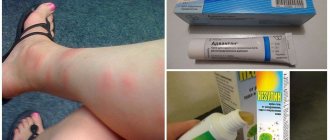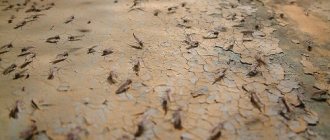The term “midges” may mean:
- Insects according to the official scientific classification, belonging to the midge family.
- Insects belonging to other families, but called midges because of their characteristic appearance and small size.
Both groups include species that are capable of drinking blood and biting people and domestic animals.
Carnivorous midges and insects similar to them in appearance and lifestyle are part of the midges - a group of blood-sucking flying pests. Depending on the area, the species composition of midges may vary, but the bite of any midge looks almost the same. The symptoms and intensity of the reaction are much more influenced by the individual characteristics of the body and immunity of the bitten person. The recommendations for first aid and treatment of midge bites described below are presented for informational purposes; only a doctor should make a diagnosis and prescribe treatment, especially for acute reactions.
Midge bite: photo
A midge bite can appear to be of two types:
- A dark maroon, small dot if the insect has a mouthpart capable of piercing the skin and drinking blood through a special proboscis, similar to what mosquitoes do.
- A small, red, round micro-abrasion with torn edges, if the insect does not have a sucking proboscis and is forced to literally tear out a piece of skin when biting.
At first, a midge bite on a person, especially if it is a type 2 bite, may bleed, causing a dried crust to form on it.
If a lot of midge saliva gets into the wound during a bite, the blood may, on the contrary, not clot for a long time and the wound will constantly burn, as if it appeared just a couple of seconds ago. At this stage, it is important to disinfect the bite and prevent infection from entering the wound. A midge bite may be accompanied by one or more skin manifestations, such as:
- Induration at the site of skin damage
- Redness of the skin around the bite
- Swelling and hardening of tissues
The intensity of redness and swelling and their size depend on the condition of the body and are purely individual. This can be either a perfectly round area with a diameter of 0.5–1 centimeter, or a spot of arbitrary shape, with a diameter of 5–10 centimeters or more. If the reaction to a bite occurs quickly, and the consequences become more and more widespread, then in addition to skin irritation from the bite there is also an allergy.
Features of culicidosis
If during a normal body reaction the bites go away on their own in three days or less, then with culicidosis they may not go away for a month. Moreover, lumps from several bites can join together and form single huge papules. Such lumps can be huge in area, swollen and very painful.
As a rule, an acute allergic reaction to mosquito bites appears already in childhood. A sudden reaction may indicate changes in the body, such as a malfunction of a particular organ or the presence of a parasitic infection.
Midge bite: photos and symptoms
A midge bite, if it looks something like the one in the photo, may be accompanied by the following symptoms:
- Itching
- Burning
- Monotonous dull pain
- Sharp throbbing pain
- Excessive skin sensitivity in the bite area
- Disappearance of skin sensitivity in the bite area
Primary symptoms, as well as the appearance of the bite, are individual and depend on the organism.
If an allergy occurs to a midge bite, it can be expressed through:
- Itchy skin outside of the bite
- Red spots on the skin not related to the bite
- Swelling of the mucous membranes of the larynx, mouth and nose
- Watery eyes
- Nasal congestion
Symptoms can appear one at a time, in random combinations, or all at once.
With a large number of bites and intense allergies, a general deterioration in well-being may be observed:
- Weakness
- Dizziness
- Nausea
- Dyspnea
- Pressure surges
- Increased body temperature
- Excessive light sensitivity of the eyes
If the symptoms reach this stage, you have problems breathing, and the bite literally grows before your eyes and is very painful, consult a doctor immediately, as an allergic reaction can result in anaphylactic shock, which can already be fatal.
You can see what a midge bite looks like in the photo, but remember that the intensity in each individual case can be different and also depends on the place where the person was bitten. On delicate and thin areas of the skin - eyelids, lips, face, inner thighs, between the fingers and toes, the reaction may be more pronounced and noticeable.
Symptoms of an insect bite
The consequences of an attack vary. It all depends on the reaction of the victim’s immune system. Symptoms of a bite are usually similar, but the difference in severity can be significant.
Local manifestations are:
- itching;
- change in skin color;
- edema;
- pain;
- swelling.
Doctors strongly do not recommend scratching the wound. This will cause it to fester due to infection.
In addition to the skin manifestations described above, a general reaction sometimes occurs:
- fever;
- malfunction of the respiratory system, for example, its stop;
- tachycardia (rapid heartbeat);
- dizziness, fainting;
- severe decrease in blood pressure.
The appearance of non-critical symptoms (itching, minor rash, slight swelling or thickening) does not require specialist intervention.
Note! You just need to treat the affected area. But there is a dangerous allergic reaction. Death in the absence of emergency intervention occurs within a few minutes. Anaphylactic shock is the cause of death.
How long does a midge bite take to heal?
How long the swelling from a bite lasts depends on your health condition. On average this is:
- For mild skin reactions – from 1 to 4 days.
- For local allergies – from 4 days to 1.5 weeks.
- For an initially severe allergic reaction – from 1 to 2 weeks.
In addition to allergies, the duration of the presence of edema can also be affected by the location where it is located and the rate of metabolic processes in the body. With proper treatment and supportive care, intense swelling in most cases is relieved within 1–3 days; further recovery gradually eliminates the remaining symptoms within 10–14 days. How long the bite lasts and how long it takes for it to heal completely so that not a trace remains of it depends on the speed of skin cell regeneration, which is also highly individual and can take from a week to 1 month or more.
Bitten by a midge: what to do
If you are bitten by a midge, the first thing you need to do is disinfect the wound. Depending on what you have on hand, the following may be suitable for this purpose:
- Miramistin
- Chlorhexidine
- Hydrogen peroxide
- Iodine
- Boric alcohol
- Vodka
Alcohol-containing products disinfect, but burn the skin.
Because of this, wounds may take longer to heal and leave scars. Miramistin, chlorhexidine and peroxide act painlessly, are more delicate and at the same time no less effective. In order to soothe the itching and burning for a while, until you get a special ointment for insect bites, you can:
- Wipe the area around the bite with ice wrapped in a piece of cloth.
- Apply frozen food or something cold to the bite, covered with gauze or a piece of cotton pad.
- Apply baking soda to wet skin around the bite.
- Apply fragrance-free hand cream or chapstick to the skin around the bite.
Nothing should come into direct contact with the wound, and any compositions should be applied only to the skin around the bite, and not to the bite itself.
After you disinfect the wound in one way or another, monitor the reaction and take appropriate measures as necessary. Further actions already relate to the treatment of the bite and are described in the section below.
Midge bite: treatment
The following remedies are suitable for treating midge bites without complications:
- Iricar
- Kuterid
- Eplan
- Beloderm
- Belogent
- Exalb
- Afloderm
- Cycaderma
- Fenistil
- Butadion
They will soothe itching and burning, help relieve swelling faster and promote faster healing of wounds.
When choosing what to treat bites with, carefully read the instructions for use of the drug and strictly follow the dosage standards and frequency of application of the product. If you have allergies, you can take antihistamine tablets, which will reduce the severity of symptoms or stop them altogether:
- Clarotadine
- Claridol
- Vero-Loratadine
- Clarifer
- Diazolin
- Lomilan
- Clargothyl
- Erolyn
- Suprastin
If antiallergic drugs and ointments for bites, which can be purchased at any pharmacy without a prescription, are not enough for you and the midge bite continues to bother you, further treatment should be prescribed by a doctor.
Which doctor should I contact if I have a midge bite?
Where to go if you are bitten by a midge depends on the situation:
- If you are bitten and have a violent reaction right now, you can go to the nearest trauma center.
- If allergies develop and there is a threat of anaphylactic shock, you can call an ambulance.
- When some time has already passed since the bite and your health allows it, contact a therapist at the clinic to which you are attached, he will give you a referral to the right specialist.
In commercial clinics, you can immediately make an appointment directly with a dermatologist or allergist.
If you already know that you are allergic to insect bites, prepare for the summer season in advance.
- Always have a first aid kit with a standard set of supplies on hand.
- Visit an allergist and, based on tests and tests, develop with your doctor an individual approach to relieving your symptoms.
- Add the necessary supplies to your first aid kit and take them with you when you go outdoors.
- Just in case, write down in your smartphone all the necessary addresses and telephone numbers of medical institutions near your dacha or the place where you plan to spend time outdoors and may be bitten.
These measures may seem too difficult to implement or completely unnecessary, but if you or your loved ones have allergies that can be life-threatening, then they are more than justified.
Despite the frightening prospects of midge bites, they can go away without any treatment at all in a few days, with virtually no symptoms other than mild itching and redness. Any reaction is individual, so the approach to treatment must be determined according to the situation and, preferably, together with a doctor.
What insects bite humans and why are their bites dangerous?
People often suffer from mosquito bites. Blood suckers cause allergies and carry infections. There are three types of mosquitoes living in Russia:
- Ordinary.
- Aedes.
- Malarial.
The former prefer urban areas, while the latter are found outside the city. Only females bite because they have piercing-sucking mouthparts. When blood is sucked, poison is injected into the body along with saliva.
It is believed that a person can withstand up to 400 bites without complications. The first bite in life is painless, but sensitivity to proteins in saliva occurs. In subsequent times, red blisters form on the body. People with a predisposition to allergies experience severe consequences.
Bedbugs, fleas and lice are miniature bloodsuckers that live in the house. Fleas live on the fur of domestic animals: dogs, cats, rats, rabbits. When bitten, an anesthetic substance is released, so at first the site of injury does not hurt.
Flea bites
Over time, red lesions appear that are very itchy and then transform into small blisters with blood clots in the middle. Red dots are accompanied by pain. Such insects bite places where the skin is thin:
- ankles;
- shin;
- top of the foot.
Body or body lice live on clothing and linen. Their bites pose a threat to humans. The difference with fleas is that lice do not jump. The proboscis is used for biting. The parasite's saliva contains painkillers and substances that prevent blood from clotting. For this reason, pain and itching are not felt immediately.
After the bite, the area swells and a red dot is visible in the center. Single wounds heal in 3–4 days, but with constant contact lice develop. Lice bite the stomach, back, sides and limbs. They live in clothes and bedding. Found in fitting rooms of stores, tents, hotels, sanatoriums and transport.
Bedbug bites hurt more than mosquito bites. The area of skin turns red and becomes tight, and a small bump forms in the center. This reaction can easily be confused with chickenpox. Damage from bedbugs is characterized by the following symptoms:
Bedbug bites
- The contour of the edema is clearly defined.
- Single punctures are not made, so the marks form a path. The intervals between red cones are 2–4 cm. There are several dozen such paths.
- Bedbugs bite at night, so the damage is visible after sleep.
- The place hurts and burns. Sometimes peeling occurs.
Bites stand out more on the face and neck because the skin in these areas is thin. After the night, marks appear on the back, arms, legs and other open areas. Bedbugs never bite the hairline. If there is no allergy to the bites, everything goes away in 2-3 days.
An attack by a bee, hornet, or wasp poses a threat to life if a person has individual intolerance. The wasp and hornet have a smooth sting, so these insects pierce the skin 2-3 times. The hornet does not always use a sting, but shoots venom. Severe pain is associated with acetylcholine in the poison, which activates the functioning of neurons. Phospholipases and orientotoxin destroy cell walls, so inflammation and suppuration begin. The remaining components of the poison provoke rapid heartbeat, swelling and difficulty breathing.
The wasp stings 4–5 times and injects up to 0.4 mg of poison. Road wasp stings cause unbearable pain, swelling and redness. After a bee stings, the insect dies because it loses its organs. The sting remains in the wound, and this makes the pain increase. The affected area swells and itches, but symptoms subside within 30–60 minutes. Allergy sufferers are sent to the hospital to avoid serious complications.
Tick bite
Ticks bite often in summer. Females feed heavily on blood to lay eggs. When hungry, they smell prey 10 meters away. They cling to a person with their front paws, which act as tentacles. Parasites grab onto fibers of fabric, wool, and hairs on the skin. The insect is difficult to shake off because it has miniature claws on its limbs and bristles along its body.
Ticks choose to feed on the groin area, armpits, neck, and head. They go unnoticed for a long time due to substances that prevent pain and blood clotting. At the site where the insect dives, inflammation and itching occur, and the skin becomes red. If, after removal, the insect's head remains in the body, fester occurs. Tick bites cause angioedema and serious diseases: borreliosis, encephalitis, tularemia.
Spiders are predators that inject neurotoxic or hemolytic venom into their prey. The degree of damage depends on the type of insect. The house spider does not pose a health hazard, and pain and itching go away after 2–3 days. After a tarantula attack, swelling remains. The blister becomes white with red edges, and when it bursts, a wound is formed. If not treated in a timely manner, the damage turns into an ulcer. The bite of a recluse spider looks similar. Karakurt leaves a small stain that disappears soon.










